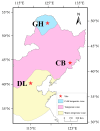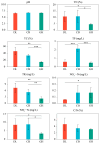Comparative Analysis of Bacterial Community Structures in Earthworm Skin, Gut, and Habitat Soil across Typical Temperate Forests
- PMID: 39203516
- PMCID: PMC11357350
- DOI: 10.3390/microorganisms12081673
Comparative Analysis of Bacterial Community Structures in Earthworm Skin, Gut, and Habitat Soil across Typical Temperate Forests
Abstract
Earthworms are essential components in temperate forest ecosystems, yet the patterns of change in earthworm-associated microbial communities across different temperate forests remain unclear. This study employed high-throughput sequencing technology to compare bacterial community composition and structure in three earthworm-associated microhabitats (skin, gut, and habitat soil) across three typical temperate forests in China, and investigated the influence of environmental factors on these differential patterns. The results indicate that: (1) From warm temperate forests to cold temperate forests, the soil pH of the habitat decreased significantly. In contrast, the physicochemical properties of earthworm skin mucus exhibited different trends compared to those of the habitat soil. (2) Alpha diversity analysis revealed a declining trend in Shannon indices across all three microhabitats. (3) Beta diversity analysis revealed that the transition from warm temperate deciduous broad-leaved forest to cold temperate coniferous forest exerted the most significant impact on the gut bacterial communities of earthworms, while its influence on the skin bacterial communities was comparatively less pronounced. (4) Actinobacteria and Proteobacteria were the predominant phyla in earthworm skin, gut, and habitat soil, but the trends in bacterial community composition differed among the three microhabitats. (5) Mantel tests revealed significant correlations between bacterial community structures and climatic factors, physicochemical properties of earthworm habitat soil, and physicochemical properties of earthworm skin mucus. The findings of this study offer novel perspectives on the interplay between earthworms, microorganisms, and the environment within forest ecosystems.
Keywords: bacteria; diversity analysis; earthworm; environmental factors; mantel test.
Conflict of interest statement
The authors declare no conflicts of interest.
Figures









Similar articles
-
A comparison of microbial composition under three tree ecosystems using the stochastic process and network complexity approaches.Front Microbiol. 2022 Oct 10;13:1018077. doi: 10.3389/fmicb.2022.1018077. eCollection 2022. Front Microbiol. 2022. PMID: 36299726 Free PMC article.
-
Bacterial Keystone Taxa Regulate Carbon Metabolism in the Earthworm Gut.Microbiol Spectr. 2022 Oct 26;10(5):e0108122. doi: 10.1128/spectrum.01081-22. Epub 2022 Aug 16. Microbiol Spectr. 2022. PMID: 35972247 Free PMC article.
-
Ecosystem responses to exotic earthworm invasion in northern North American forests.Res Ideas Outcomes. 2019 Apr 1;5:e34564. doi: 10.3897/rio.5.e34564. Res Ideas Outcomes. 2019. PMID: 31032397 Free PMC article.
-
Geographical variation in soil bacterial community structure in tropical forests in Southeast Asia and temperate forests in Japan based on pyrosequencing analysis of 16S rRNA.Genes Genet Syst. 2017 Sep 12;92(1):1-20. doi: 10.1266/ggs.16-00013. Epub 2016 Dec 21. Genes Genet Syst. 2017. PMID: 28003572
-
Association between Soil Physicochemical Properties and Bacterial Community Structure in Diverse Forest Ecosystems.Microorganisms. 2024 Apr 3;12(4):728. doi: 10.3390/microorganisms12040728. Microorganisms. 2024. PMID: 38674672 Free PMC article.
References
-
- Van Groenigen J.W., Van Groenigen K.J., Koopmans G.F., Stokkermans L., Vos H.M.J., Lubbers I.M. How fertile are earthworm casts? A meta-analysis. Geoderma. 2019;338:525–535. doi: 10.1016/j.geoderma.2018.11.001. - DOI
-
- Shuster W.D., Subler S., McCoy E.L. Deep-burrowing earthworm additions changed the distribution of soil organic carbon in a chisel-tilled soil. Soil Biol. Biochem. 2001;33:983–996. doi: 10.1016/S0038-0717(01)00002-5. - DOI
-
- James S.W. Soil, Nitrogen, Phosphorus, and Organic Matter Processing by Earthworms in Tallgrass Prairie. Ecology. 1991;72:2101–2109. doi: 10.2307/1941562. - DOI
Grants and funding
LinkOut - more resources
Full Text Sources

